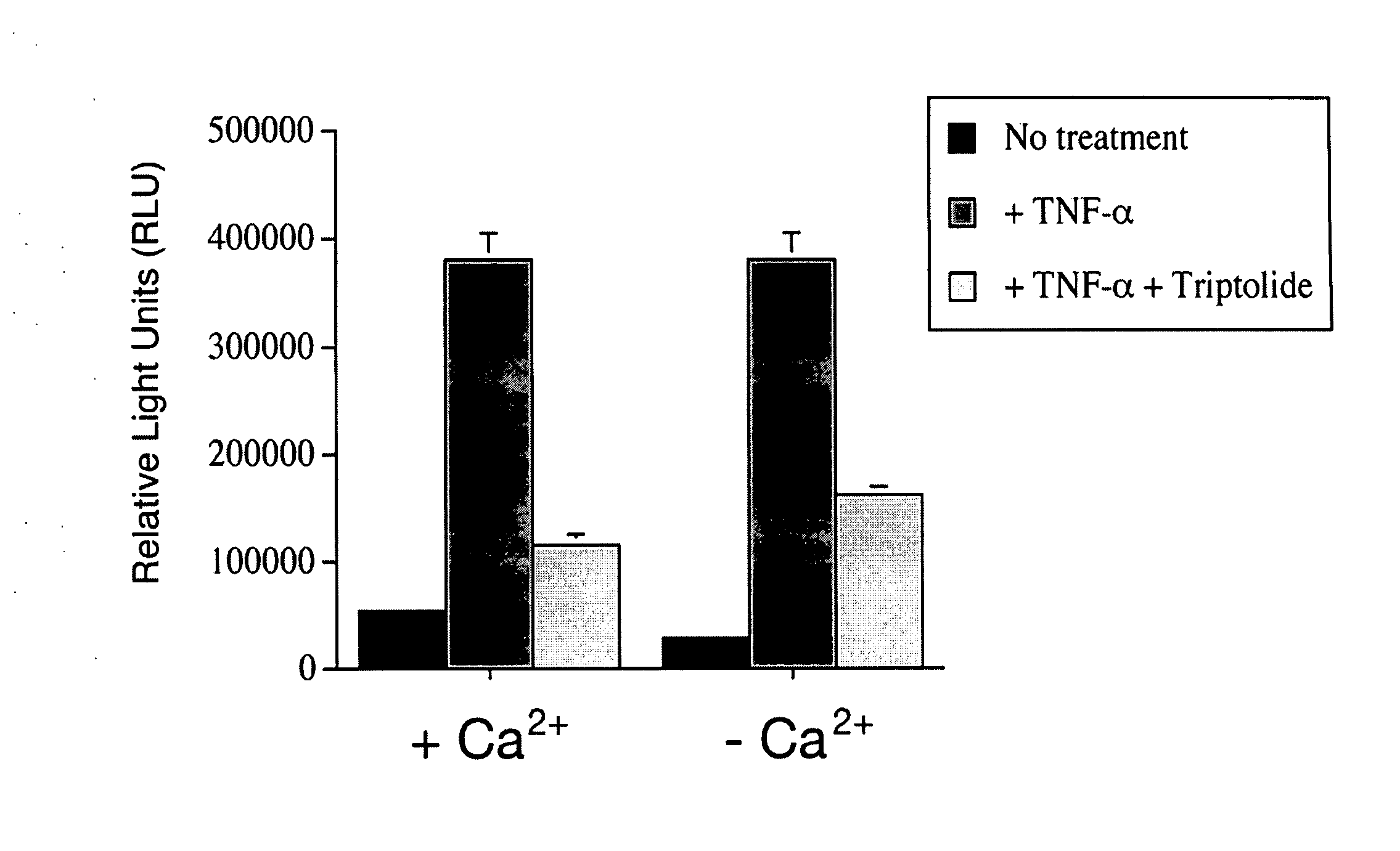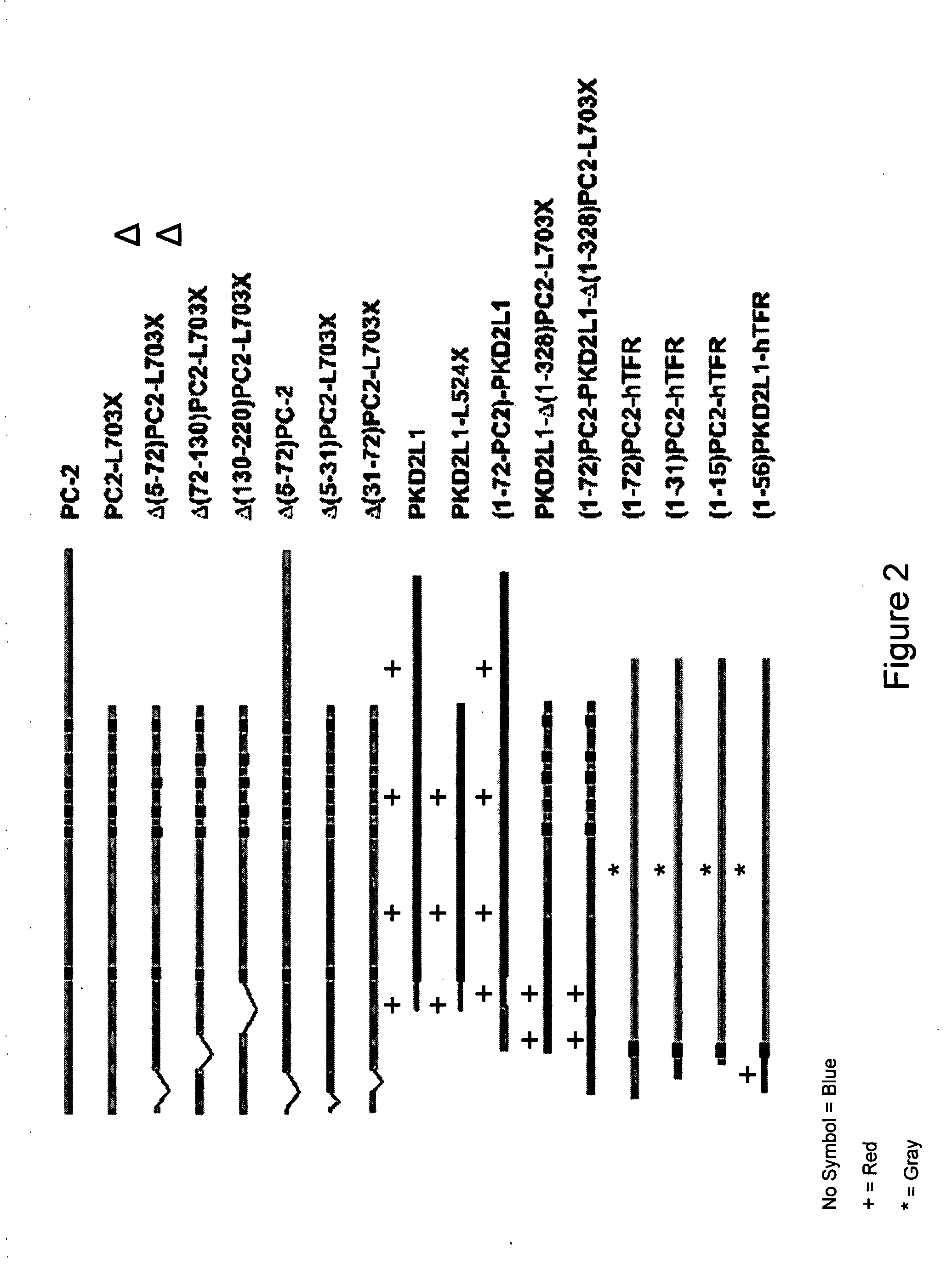Compositions and methods relating to polycystic kidney disease
a polycystic kidney and kidney disease technology, applied in the field of polycystic kidney disease, can solve the problems of end-stage renal failure, loss of fully differentiated state, increased proliferation, net fluid secretion and the formation of fluid-filled cysts in the kidney, etc., to stimulate intracellular calcium release, arrest cell growth, and disregulated cell proliferation
- Summary
- Abstract
- Description
- Claims
- Application Information
AI Technical Summary
Benefits of technology
Problems solved by technology
Method used
Image
Examples
example 1
PC-2 Trafficking to Cilia is Independent of PC-1
[0090] Full length PC-2 is retained in the ER in cultured epithelial cells in the non-ciliated state. Once cells form cilia, in addition to its ER location, full length epitope-tagged PC-2 traffics to the plasma membrane overlying primary cilia in both LLC-PK1 and MDCK epithelial cells. PC-2 is not detected on the remainder of the cell surface plasma membrane (Cai et al., 1999; Koulen et al., 2002; Cai et al., 2004). Truncation of the COOH-terminus of PC-2 upstream of amino acid E787 results in trafficking of the residual protein to the general cell surface even before cilia form (Cai et al., 1999; Koulen et al., 2002). Applicant determined that addition of a COOH-terminal EGFP fusion to full length PC-2 does not alter cilial trafficking properties of the full length protein. The truncation mutant, PC-2-L703X, lacking the bulk of the COOH-terminus including the putative PC-1 interaction domain (Qian et al., 1997; Tsiokas et al., 1997)...
example 2
An NH2-Terminal Domain Necessary for Cilial Location of PC-2
[0092] Applicant sought to define the domains of PC-2 that direct it specific trafficking properties. For this purpose, Applicant produced a series of deletion and fusion constructs of human PC-2. Deletion of amino acids 5-72 resulted in loss of cilial location of the COOH-terminal truncated peptide Δ(5-72)PC2-L703X. By contrast, deletion of amino acids 72-130 or 130-220 had no effect on trafficking to cilia of the respective Δ(72-130)PC2-L703X and Δ130-220)PC2-L703X peptides. Applicant excluded the possibility that loss of cilial location resulted from differences in the expression of the mutant peptides. Robust expression of the proteins deleted for amino acids 5-72 was seen in cell body using confocal microscopy and the proteins showed the expected expression and migration by SDS-PAGE of total cell lysates detected by immunoblotting anti-HA epitope antibodies.
[0093] Since the PC-2-L703X backbone lacks the COOH-terminus...
example 3
Subcellular trafficking of NH2-terminal domain mutants of PC-2
[0094] Applicant examined the differences in the intracellular trafficking of PC-2-L703X and Δ(5-72) PC2-L703X. The proteins both showed a perinuclear and cytosolic expression pattern and co-localization with calnexin (data not shown) indicative of location in the ER. PC-2-L703X also showed partial co-localization with the Golgi marker GM130 (Nakamura et al., 1995). The Δ(5-72) PC2-L703X form did not co-localize with this Golgi marker, indicating that deletion of the NH2-terminal domain of PC-2 results in failure to traffic into the Golgi.
[0095] Glycosylation analysis in ciliated cells was used to further examine trafficking of these proteins. Normally, the fraction of PC2-L703X that is expressed on the cell surface acquires resistance to Endoglycosidase H (Endo H) as it passes through the middle Golgi on its way to the plasma membrane. The Endo H resistant species appears as a slower migrating band in immunoblots (Cai ...
PUM
| Property | Measurement | Unit |
|---|---|---|
| time | aaaaa | aaaaa |
| time | aaaaa | aaaaa |
| size | aaaaa | aaaaa |
Abstract
Description
Claims
Application Information
 Login to View More
Login to View More - R&D
- Intellectual Property
- Life Sciences
- Materials
- Tech Scout
- Unparalleled Data Quality
- Higher Quality Content
- 60% Fewer Hallucinations
Browse by: Latest US Patents, China's latest patents, Technical Efficacy Thesaurus, Application Domain, Technology Topic, Popular Technical Reports.
© 2025 PatSnap. All rights reserved.Legal|Privacy policy|Modern Slavery Act Transparency Statement|Sitemap|About US| Contact US: help@patsnap.com



